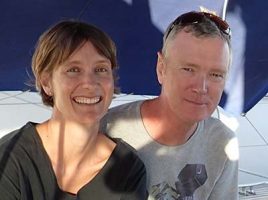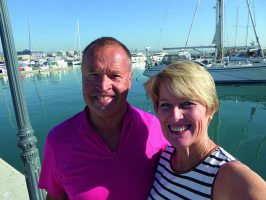World cruising is generally safe with a few basic precautions, say two cruising couples, despite some hotspots which are best avoided
Recent attacks on sailors in the Caribbean and Indonesia have raised concerns about the safety of world cruising, but the reality is that with a small amount of caution this is a safe way of life, very much more so than in most places ashore, and bolstered by a strong and supportive cruising community.
But cruisers say that you have to assess the level of risk, or comfort, you are prepared to accept as a couple or group. This depends on where in the world you are sailing and, in areas such as parts of the Mediterranean, a changing political situation. Two cruising couples offer their advice.
 Kate Mackay and Rory Garland have sailed together for over 15 years. Before this Garland used to be a delivery skipper and raced to international level. Between them they have crossed the South Atlantic, the North Atlantic numerous times, the Pacific, sailed up and down the east and west coasts of the US, transited Panama and Suez, and cruised the Caribbean and Pacific islands for many years. Their last trip involved sailing from the UK to Fiji.
Kate Mackay and Rory Garland have sailed together for over 15 years. Before this Garland used to be a delivery skipper and raced to international level. Between them they have crossed the South Atlantic, the North Atlantic numerous times, the Pacific, sailed up and down the east and west coasts of the US, transited Panama and Suez, and cruised the Caribbean and Pacific islands for many years. Their last trip involved sailing from the UK to Fiji.
Avoid places with known risks
‘The only time we have had anything taken from our boat was in the Hamble River in the UK,’ they report.
‘However, we did spend a short period cruising in Venezuela and felt very vulnerable when coastal cruising and at night. We were followed and approached by a suspicious fishing boat on one passage, and resorted to talking loudly on Ch 16 to a pretend buddy boat “just behind us”. The fishing boat immediately backed off and disappeared.
‘As a rule, we do everything we can to avoid places with known risks. We’ve always said that if we have to live on the boat with bars on the hatches and locking ourselves in at night, we will go somewhere else or stop sailing.
‘For the same reason, we will not consider having firearms on the boat. We’ve met some cruisers who do, but our suggestion would be only carry them if you are completely comfortable with using them and taking the consequences.’
(See Elaine Bunting’s blog on guns on board HERE)
‘Before heading off on any major passage we always try to get a measure of the risks by trawling through all the blogs of other boats that have taken our proposed route, as well as consulting the latest information on Noonsite – www.noonsite.com. We also consult the UK’s Foreign & Commonwealth Office (FCO) country advice. It was as a result of FCO advice that we decided against sailing to Davao in the Philippines, subsequently the scene of a very serious abduction incident.

Streetcar
‘Part of the reason we love cruising in the Pacific so much is because it is, by and large, very safe and secure. We always sleep with our windows and hatches open.
‘In our opinion, it’s critical to make your own decisions about what level of risk you are prepared to accept while cruising. Wherever possible, find the first-hand accounts of incidents so you can remove the rumour and conjecture that so often embellishes security stories.
Precautions
‘The precautions we take when we are feeling vulnerable are as follows:
- If at all possible, we will not stay in an anchorage unless another boat is there.
- Keep the handheld VHF and a very powerful torch by the bed.
We always do the following as a matter of course wherever we are:
- Lock the boat when we get off for any time.
- Haul the dinghy and outboard at night.
- Lock the dinghy and outboard if we are tying up at a dock.
- Don’t leave anything hanging on the guardwires when the boat is unoccupied or at night.
- Pull up the boarding ladder and close the guardwires at night.
- If carrying cash, split it into a big stash and small stash and be prepared to hand over the small stash (making sure the small stash is sufficiently large to be likely to appease a robber).
- Talk to local people and other cruisers about the local security situation (we used to do this a lot in the Caribbean).
• On a previous boat we had big low wattage spreader lights, which we always felt would work well in scaring off potential intruders. Ideally, you’d want to be able to switch these on from inside the cabin.’
The Mediterranean situation
 Canadians Barb and Con Sprenger are currently exploring the Med aboard their 52ft Nauticat, Big Sky. They have visited 53 countries and five continents, often well off the beaten path. The Sprengers say they have never been worried about theft. Safety in many parts of the Mediterranean these days means learning a new set of rules.
Canadians Barb and Con Sprenger are currently exploring the Med aboard their 52ft Nauticat, Big Sky. They have visited 53 countries and five continents, often well off the beaten path. The Sprengers say they have never been worried about theft. Safety in many parts of the Mediterranean these days means learning a new set of rules.
“We’ve visited every single country that borders the Med with the exception of Algeria, Libya, Egypt and Lebanon and we have never feared for our safety, or of being robbed, or threatened. Likewise in the Black Sea when we visited Romania and Bulgaria.”
They admit, however, that once on a public pier in Corinth four men boarded at 0300 and attempted to open the companionway. Barb woke and knocked on the inside of the door calling loudly, “Get off the boat!” They did.
 “A new and more serious problem, mainly in the waters between Turkey and Greece, and North Africa and Europe is refugees and migrants. They cram into unseaworthy craft and rubber boats, setting off in the night on their desperate journey to Europe often without navigation lights and too low in the water for radar to read.
“A new and more serious problem, mainly in the waters between Turkey and Greece, and North Africa and Europe is refugees and migrants. They cram into unseaworthy craft and rubber boats, setting off in the night on their desperate journey to Europe often without navigation lights and too low in the water for radar to read.
“In the spring of 2012, when the migration began, we were on the island of Agathonisi, Greece and witnessed a partially deflated dingy being towed to the quay with 29 relieved Syrian refugees aboard with possibly three lifejackets between them. The emotion was raw, as stress-released tears streamed down the faces of men, women and children.
“Since then, perilous situations have escalated to the point where every day we’re on the water we hear the desperate Mayday calls and eagerly await the radio rescue transmissions from the tireless Greek coastguards. Sadly, more often than not the migrant/refugee boats are ill-equipped and unable to give proper charted locations.
“In April last year, while on a two-day sail to Kos from Limassol, Cyprus with strong wind and choppy seas, we acted as a Mayday relay near Rhodes. Communication was broken and little could be shared with the Greek coastguard via VHF. On arrival in Kos, we learned the heartbreaking news that three people had drowned close to Rhodes, and as many as 700 were feared dead off Libya.
What to do about refugees
“We were given the following instructions by the Greek coastguard if we were to encounter a boat full of refugees:
- Do not go close enough for them to board, as you will be responsible for getting them safely to land.
- Immediately contact the Coastguard on VHF and remain near the refugee boat until help arrives.
- Toss them water (keeping a safe distance), lifejackets and blankets in floating bags.
- If their boat is sinking, begin rescue procedures.
“The autumn seas can be terrifyingly unsafe for people in small craft and our emotions ran high listening to desperate rescues or sadly hearing of the lost lives.
“We have never felt threatened by the refugees and migrants we’ve met on land, and have been recipients of their gracious and exhausted appreciation.”
General safety tips
These are our tips for general safety that we have put into place, but haven’t needed:
- A fake wallet is kept in an easy-to-access location with a few euros and useless credit cards inside.
- Most of our electronics are hidden in locations I can’t share, because that would be telling.
- Bear spray is kept in an easy location for quick access if ever needed.
- We do not carry guns aboard.




